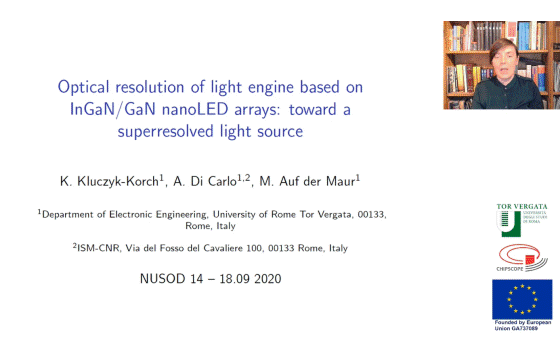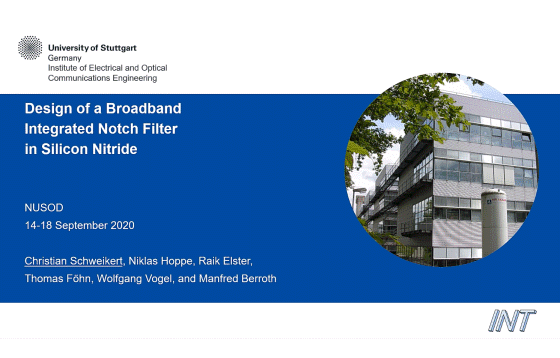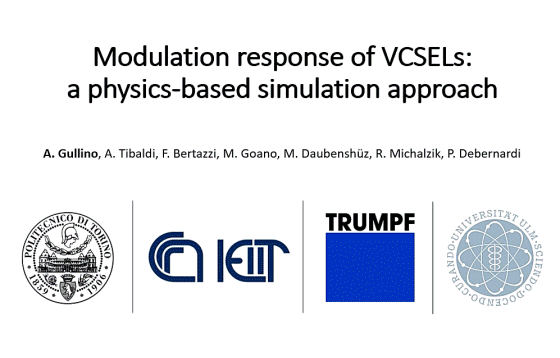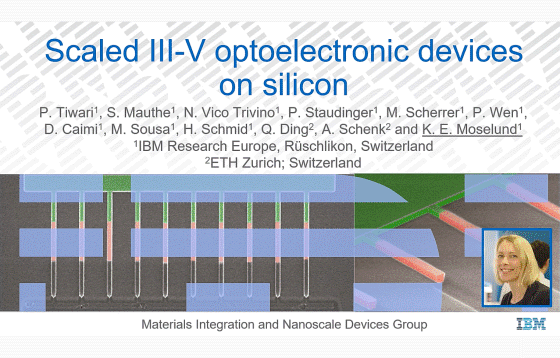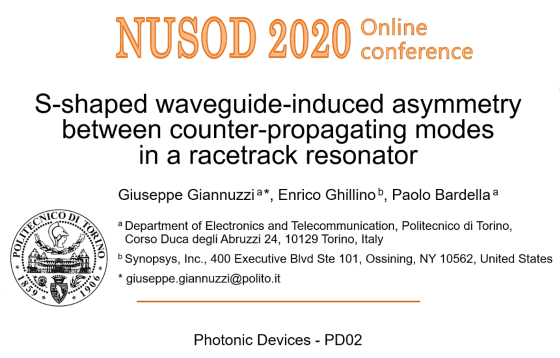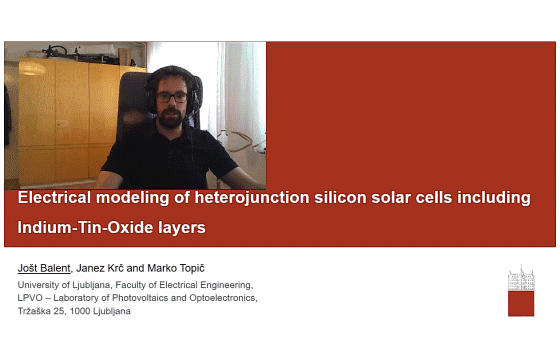


We present a comprehensive simulation flow for the estimation of photon detection efficiency as a function of wavelength in InGaAs/InP single-photon avalanche diodes (SPADs) at low temperature. We introduce a joint modelling of electrical and optical properties for SPAD detectors. We also highlight how accurately different parameters have to be calibrated in order to achieve […]
LED01–Optical resolution of light engine based on InGaN/GaN nanoLED arrays: toward a superresolved light source
We present the optical simulations of a novel illumination source based on nanoLED arrays for the possible application in superresolved microscopy. We are simulating the images of various gold nanoparticle arrangements collected by the proposed nanoillumination microscope. The images are then analysed in order to understand the capabilities and limitations of the microscope.
N01–Quantum corrections to the efficiency of solar cells with conductive nanostructured layers
It was shown in many experiments that the incorporation of metallic nanostructures into photovoltaic devices results in the enhancement of solar cell efficiency. Most simulations of such devices are based on classical electrodynamics and neglect quantum effects arising from nanosized metallic structures. Here, we look at nonlocal electron-electron interactions, Lorentz friction and strong coupling of […]
SC01–Device level modeling of intermediate band quantum dot solar cells
Among many material candidates for next-generation solar cells, quantum dots offer unique opportunities. Aiming to maximally harness their nanoscale bandgap engineering, in this work we outline a multiscale, multiphysics modeling approach for the device level simulation of quantum dot solar cells. Examples of experimental validation are discussed, emphasizing the potential of light trapping techniques towards […]
D09–Efficient Absorption Enhancement Approaches for AlInAsSb Avalanche Photodiodes for 2-μm Applications
We describe two photon-trapping structures to enhance the quantum efficiency of AlInAsSb APDs for 2-μm detection. Finite-difference time-domain (FDTD) simulations show the absorption can be enhanced by more than 100 % with a triangular lattice photonic crystal, and nearly 400 % by applying a metal grating, for normal incidence at 2 µm.
D06–Scaling Effects on the Plasmonic Enhancement of Butt-Coupled Waveguide Photodetectors
We employed 3D opto-electrical simulations to study the scaling effects of a plasmonic structure on the optical performance of butt-coupled waveguide photodetectors by placing an Ag stripe on top of the intrinsic region. It is found that cut-offs which are limited by carrier drift in the high-field region of the non-plasmonic device improve with longer […]
PD05–Design of a Broadband Integrated Notch Filter in Silicon Nitride
A broadband integrated notch filter, using the silicon nitride (Si3N4) platform, is presented. It achieves an extinction ratio (ER) of 60 dB and a full width at half maximum (FWHM) of 10 nm at the central wavelength (CW) 785 nm. The main filter components are Bragg gratings (BGs). For separating the occurring reflections from the […]
PD10–Statistical Analysis of Nonlinear Harmonic Distortions in Single Drive Mach Zhender Modulators
In this preliminary investigation, a statistical approach is proposed to analyze the nonlinear harmonic distortions introduced by Mach-Zehnder modulators (MZMs) in response to arbitrarily random radio frequency (RF) excitation signals. The proposed analysis is based on a simple and accurate reformulation of the MZM transfer characteristics using the Taylor series expansion and the Binomial Theorem. […]
LD01–Third Order Dispersion in Optical Time Delayed Systems: The case of Mode-Locked Vertical External-Cavity Surface-Emitting Lasers
Time-delayed dynamical systems materialize in situations where distant, point-wise, nonlinear nodes exchange information that propagates at a finite speed. However, they are considered devoid of dispersive effects, which are known to play a leading role in pattern formation and wave dynamics. We show how dispersion may appear naturally in delayed systems and we exemplify our […]
N02–Nucleation chronology and electronic properties of In(As,Sb,P) graded-composition quantum dots
We have studied nucleation process and electronic properties of graded-composition quantum dots(GCQDs) grown from In-As-Sb-P in the liquid phase for application in mid-infrared devices like photoresistors or photoconductive cells. The GCQD ensemble exhibits diameters of 10 – 120 nm and heights of 2 – 20 nm. Compositional grading is a typical feature of quantum dots […]
SC03–Microscopic approach to reciprocity and photon recycling in ultrathin solar cells
In contrast to their bulk counterparts, ultrathin solar cells exhibit bias-dependent optical properties. This has severe implications for the validity of conventional opto-electronic reciprocity relations. We review the predictions of this phenomenon from quantum-kinetic theory and discuss the experimental confirmation, as well as the extension of the theoretical framework for the rigorous assessment of photon […]
NM09–A fiber optic probe for thermal therapy
We demonstrate a novel fiber optic device for controlled generation of photothermal effects. The fiber probe is pumped by a laser diode and incorporates polymer composites allowing to generate highly localized heat and obtain temperature measurements simultaneously. We analyze the temperature field in the vicinity of the device through computer simulations and these are validated […]
D07–Numerical simulation on the dependence of carrier transport characteristics on the thickness of the absorbing layer for GaAs-based blocked impurity band (BIB) terahertz detectors
The dependence of carrier transport characteristics on the thickness of the absorbing layer for Gallium Arsenide (GaAs) blocked-impurity-band (BIB) terahertz detector has been investigated in detail. It is found that responsivity linearly increases with the increased thickness of absorbing layer first, and after achieving a peak value, and then starts to dropping slowly.
PD04–Towards an efficient simulation framework for plasmonic organic hybrid E/O modulators
Due to the large computational resources required, with CPU times of the order of several days, full-wave optical simulators can be hardly exploited for the modeling and optimization of plasmonic organic hybrid electro/optic modulators. With the aim to drastically reduce such complexity, in this work we present a divide-et-impera strategy reducing the number of FDTD […]
PD11–Tunable Polarization Splitter Based on Asymmetric Dual-core Liquid Photonic Crystal Fiber
An asymmetric dual core photonic crystal fiber (ADC-PCF) tunable polarization splitter is reported and analyzed. The left core of the DC-PCF is infiltrated with nematic liquid crystal (NLC) material to control the wavelength at which coupling occurs between the dual cores of the proposed structure. Moreover, the suggested design can be tuned to split out […]
LD02–A Functional Mapping for Passively Mode-Locked Semiconductor Lasers
We present a modern approach for the analysis of passively mode-locked semiconductor lasers that allows for efficient parameter sweeps and time jitter analysis. It permits accessing the ultra-low repetition rate regime where pulses become localized states. The analysis including slow (e.g. thermal) processes or transverse, diffractive dynamics becomes feasible. Our method bridges the divide between […]
N03–A Bi quantum film potential as an inverse problem
Experiments generally only offer access to certain output parameters or spectra. When performing device simulations, we often assume that agreement of theoretical and experimental output means that the model describes the device well. However, this conclusion is by no means mandatory. Here, we show an example of a Bi quantum film where measurements show equidistant […]
SC05–Modeling of three-terminal heterojunction bipolar transistor solar cells
Three-terminal solar cells exploiting the heterojunction bipolar transistor structure combine the advantages of independently connected tandem cell architectures – suboptimal gaps, high resilence to spectral variations and to radiation damage – with a simple monolithic structure, since they do not need tunnel junctions. In this work, we study this novel device concept by means of […]
NM10–Highly Sensitive Photonic Crystal Gamma Ray Dosimeter
Highly sensitive 2D Si photonic crystal (PhC) sensor is proposed and analyzed for the detection of gamma-ray doses in the visible light region. The suggested PhC has a cavity infiltrated by poly-vinyl alcohol (PVA) polymer doped with crystal violet and carbol fuchsine dyes. The geometrical parameters of the design are studied to maximize the sensor […]
D08–Numerical simulation on the effect of the thickness of the absorbing layer on the spectral response characteristics for GaAs-based blocked impurity band (BIB) terahertz detectors
The effect of the thickness of the absorbing layer on the spectral response characteristics for Gallium Arsenide (GaAs) blocked-impurity-band (BIB) terahertz detector has been investigated in detail. It is found that Response bandwidth (BWR) is approximately a linear function of hAbs, and the relationship between the Response bandwidth (BWR) and hAbs has been given in […]
PD03–Modelling of photon recycling in optoelectronic devices using a transfer matrix method
In this work we present a generalized transfer matrix method to study the effect of the photon recycling on the performance of solar cells. Photon recycling increases the charge carrier concentration in solar cells, resulting in an increase of the open circuit voltage (Voc). The model is based on the transfer matrix method (TMM), taking […]
LD03–Modulation response of VCSELs: a physics-based simulation approach
A preliminary study of the dynamic behaviour of a GaAs/AlGaAs 850 nm VCSEL is presented, with the focus on the small-signal analysis and in particular on the optical amplitude modulation response. Simulations are performed with our in-house quantum-corrected one-dimensional drift-diffusion code D1ANA, updated to perform the AC analysis. The -3 dB cutoff frequency of the […]
IS01–Scaled III-V optoelectronic devices on silicon
In the present talk we discuss the development of the epitaxial technique Template-Assisted Selective Epitaxy (TASE) and its application for the monolithic integration of scaled III-V active photonic devices on silicon. A unique advantage of TASE for silicon photonics applications is that it enables a truly local integration of III-V material at precisely defined positions, […]
SC04–Electro-optical modeling for the design of semitransparent mixed bromide-chloride PSCs
UV-selective absorbing perovskites have attracted significant interest due to their potential applications in innovative fields, such as building integration photovoltaics. This appeal arises from the possibility to tune the bandgap by simply varying their crystal composition. In this work we present electro-optical simulations to study the effect of Cl doping in MAPb(Br1-xClx)3 based semi-transparent solar […]
NM11–Numerical Investigation of a Plasmonic Biosensor on Flexible Substrate
Surface plasmon resonance (SPR) based sensors are state of the art in bio-sensing. Here we numerically inspect a device that can induce SPR on the opposite side of planar metal films. The evanescent field of SPR can detect wide of refractive index with linear sensitivity. This device modeled on bendable PDMS substrate can launch SPR […]
D05–Enhanced dynamic properties of Ge-on-Si mode-evolution waveguide photodetectors
This work discusses coupled three-dimensional electromagnetic and electrical simulations of a Ge-on-Si waveguide photodetector where light is fed through a lateral waveguide. The numerical results show that this coupling solution leads to more uniform photon and carrier distributions along the Ge absorber compared to a conventional butt-coupled detector, allowing a broader electrooptical bandwidth for high […]
PD02–S-shaped waveguide-induced asymmetry between counter-propagating modes in a racetrack resonator
Ongoing progress in photonic integrated circuits necessitates the integration of semiconductor ring lasers (SRLs) with high performance and predictable behavior, which can be achieved when the symmetry of the SRL, which supports both clockwise and counterclockwise beam propagation, is unbalanced through loss mechanisms inside the resonator. In this work, numerical simulations were carried out on […]
LD08–Jitter Reduction of Mode-Locked Hybrid Silicon Laser With Intra Cavity Filter
We study the influence of the intra-cavity ring on dynamics, phase noise and timing jitter of a long-ring-cavity colliding pulse mode-locked laser using a delay differential equation (DDE) model. The results of dynamic show that the intra-cavity filter can suppress harmonics of 2 GHz cavity. We also find a reduction of phase noise and timing […]
IS02–Shape Optimized Photonic Integrated Circuit for Optical Computing Applications
Shape optimization techniques were quite recently applied to photonic components but to the best of our knowledge, no application to optical computing has been reported yet. Here, we present the design of a photonic integrated circuit, composed of shape optimized passive components, performing a matrix-vector product. A ≈ 2000 times gain on the overall footprint […]
SC06–Electrical modeling of heterojunction silicon solar cells including Indium-Tin-Oxide layers
In this contribution we performed opto-electrical simulations of heterojunction silicon (HJ Si) solar cell with Indium-Tin-Oxide layers included in simulations as front and rear contacts. Two-dimensional numerical simulations using Sentaurus TCAD software were carried out. We studied the effect of defect state density in p- and n-type hydrogenated amorphous silicon layers on device performance. Rigorous […]


